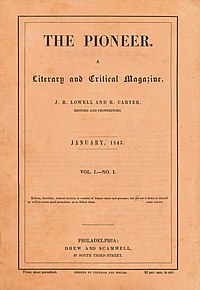The Tell-Tale Heart
| "The Tell-Tale Heart" | |
|---|---|

The Pioneer, Vol. I, No. I, Drew and Scammell, Philadelphia, January, 1843
|
|
| Author | Edgar Allan Poe |
| Country | United States |
| Language | English |
| Genre(s) |
Horror Short story Gothic Literature |
| Published in | The Pioneer |
| Publication type | Periodical |
| Publisher | James Russell Lowell |
| Media type | Print (periodical) |
| Publication date | January 1843 |
"The Tell-Tale Heart" is a short story by Edgar Allan Poe first published in 1843. It is told by an unnamed narrator who endeavors to convince the reader of his sanity, while describing a murder he committed. The victim was an old man with a filmy "vulture-eye", as the narrator calls it. The murder is carefully calculated, and the murderer hides the body by dismembering it and hiding it under the floorboards. Ultimately the narrator's feelings of guilt, or a mental disturbance, result in his hearing what he believes to be the dead man's still beating heart.
The story was first published in James Russell Lowell's The Pioneer in January 1843. "The Tell-Tale Heart" is widely considered a classic of the Gothic fiction genre and is one of Poe's most famous short stories.
It is unclear what relationship, if any, the old man and his murderer share. The narrator denies having any feelings of hatred or resentment for the man who had, he says, never wronged him. He also denies that he killed for greed. The specific motivation for murder, the relationship between narrator and old man, and other details are left unclear. It has been suggested that the old man is a father figure, the narrator's landlord, or that the narrator works for the old man as a servant, and that perhaps his "vulture-eye" represents some sort of veiled secret, or power. The ambiguity and lack of details about the two main characters stand in stark contrast to the specific plot details leading up to the murder.
"The Tell-Tale Heart" is a first-person narrative of an unnamed narrator who insists he is sane but suffering from a disease (nervousness) which causes"over-acuteness of the senses". The old man with whom he lives has a clouded, pale, blue "vulture-like" eye which so distresses the narrator that he plots to murder the old man, though the narrator states that he loves the old man, and hates only the eye. The narrator insists that his careful precision in committing the murder shows that he cannot possibly be insane. For seven nights, the narrator opens the door of the old man's room, in order to shine a sliver of light onto the "evil eye". However, the old man's vulture-eye is always closed, making it impossible to "do the work".
On the eighth night, the old man awakens after the narrator's hand slips and makes a noise, interrupting the narrator's nightly ritual. But the narrator does not draw back and, after some time, decides to open his lantern. A single thin ray of light shines out and lands precisely on the "evil eye", revealing that it is wide open. Hearing the old man's heart beating loudly and dangerously fast from terror, the narrator decides to strike, jumping out with a loud yell and smothering the old man with his own bed. The narrator then dismembers the body and conceals the pieces under the floorboards, making certain to hide all signs of the crime. Even so, the old man's scream during the night causes a neighbor to report to the police. The narrator invites the three arriving officers in to look around. He claims that the screams heard were his own in a nightmare and that the man is absent in the country. Confident that they will not find any evidence of the murder, the narrator brings chairs for them and they sit in the old man's room, on the very spot where the body is concealed, yet they suspect nothing, as the narrator has a pleasant and easy manner about him.
...
Wikipedia
